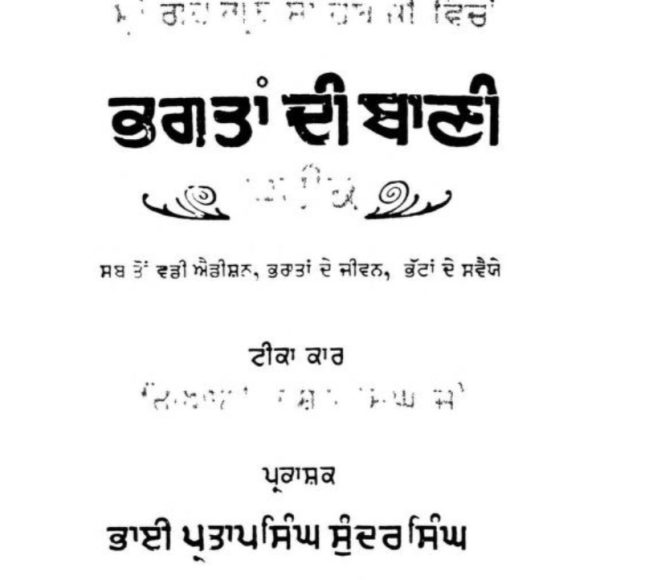BANI BHAGATAN SATIK (satik = exegesis or commentary) by Pandit Tara Singh Narotam (q.v.) is an exposition of the bani, or hymns, of the bhaktas (saints)—here, the term implies contributors to the Guru Granth Sahib other than the Gurus. The work was, according to inner evidence, completed in 1939 Bk/AD 1882, and the scribe was one Sundar Singh. It was published in AD 1907 by Rai Sahib Munshi Gulab Singh and Sons, Lahore. The book is divided into two parts: the first part (pp. 386) covers the compositions of the bhaktas included in Sikh Scripture up to Raga Gujari, and the second part (pp. 522) covers the rest of them.
The book opens with an Introduction in which the author states that bhakta bani—as included in the Guru Granth Sahib—was composed by Guru Arjan himself on behalf of the different saints and sufis. Tara Singh Narotam’s exposition is very detailed, even prolix. For instance, the exegesis of a sabda by Kabir in Raga Gauri runs into 15 pages (pp. 3953), with the author quoting profusely from old Hindu scriptures. His interpretations are colored by his Vedantic training and background.
References:
- Shergill, Surinder Singh, Pandit Tara Singh Narotam: Jivan te Rachana. Patiala, 1985
In-Depth Exploration of Bani Bhagatan Satik
The work Bani Bhagatan Satik represents a monumental effort in Sikh exegetical literature, offering an intricate commentary on the contributions of bhaktas to the Guru Granth Sahib. In this exploration, we delve deeply into its historical context, scholarly methodology, and its enduring significance for both Sikh studies and broader Indic intellectual traditions.
Historical and Intellectual Context
Composed in the late 19th century (completed in 1939 Bk/AD 1882) and later published in 1907, Tara Singh Narotam’s commentary emerged during a period of dynamic intellectual ferment in Punjab. This was a time when traditional Indic scholarship was reasserting its authority and seeking to establish concrete methodologies for interpreting sacred texts. Narotam, drawing from his Vedantic training, approached the bhakta bani with an analytical rigor that married traditional exegesis with a critical study of source materials, including ancient Hindu scriptures. His work underscores an era when Sikh intellectuals were also engaging with Vedanta, reflecting the syncretic environment of Punjabi religious thought.
Methodology and Exegesis
Narotam’s methodology in Bani Bhagatan Satik is detailed and expansive, as seen in his 15-page exegesis of a sabda by Kabir in Raga Gauri. His commentary is replete with quotations from old Hindu texts, which not only contextualize the composition within a broader Indic tradition but also reveal his deep engagement with Vedantic philosophy. The work offers:
- Layered Interpretations: His interpretations do not merely summarize the hymn’s content; they deconstruct the layers of meaning imbued by both literal and allegorical contexts. By grounding his explanations in historical and philosophical references, Narotam elucidates how the hymns were conceived as expressions of universal truths, transcending sectarian boundaries.
- Integration of Traditions: In his exposition, Narotam emphasizes that Guru Arjan’s role extended beyond mere compilation. According to his introduction, the bhakta bani was composed by Guru Arjan on behalf of various saints and sufis. This view positions the Guru as a mediator who synthesized diverse spiritual voices into a coherent corpus of Sikh scripture.
- Vedantic Coloration: His Vedantic background is evident throughout his commentaries. Narotam employs concepts prevalent in Advaita and Vishishtadvaita traditions to shed light on the mysticism and social ethos underpinning the hymns. This approach not only enriches the interpretative landscape of Sikh scripture but also reflects the intellectual cross-pollination of the time. Scholarly and Cultural Significance
Bani Bhagatan Satik holds immense scholarly significance due to its dual role as both an exegesis and a historical document. It preserves the interpretations of various saints’ compositions at a time when oral traditions were being documented and institutionalized. Some key points include:
- Preservation of Oral Traditions: By recording and interpreting the hymns of the bhaktas, Narotam’s work has helped preserve an essential strand of Sikh literature that might otherwise have been lost amid shifting oral traditions.
- Bridging Divides: His commentary builds bridges between the Sikh canon and broader Indic thought. The cross-references to Hindu scriptures and Vedantic logic provide a framework for understanding how Sikh intellectualism both borrows from and contributes to the Indian philosophical landscape.
- Impact on Later Exegesis: Subsequent scholars and commentators have found Narotam’s comprehensive exegesis invaluable. His detailed, almost encyclopedic, approach set a high standard for later works of Sikh commentary and has influenced how modern scholars interpret the Guru Granth Sahib’s embedded voices.



